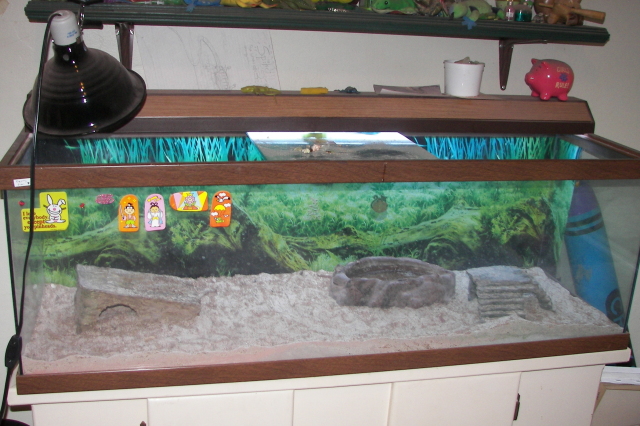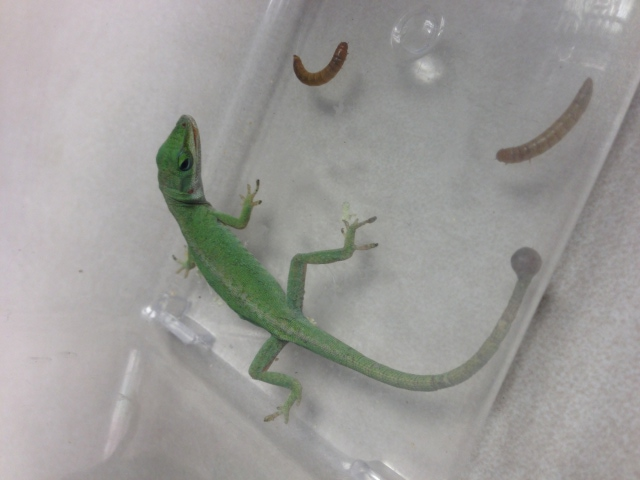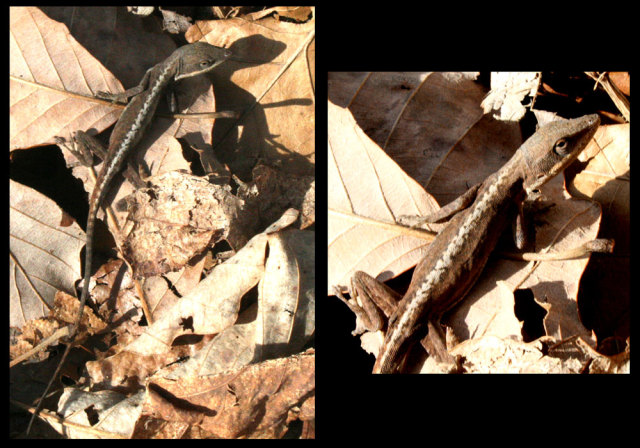QuestionQUESTION: I have three white's tree frogs, and recently one of them developed a wound on his leg. I took him to the vet (who obviously doesn't see many frogs from her reaction to seeing him), and was given a broad-spectrum anti-biotic. After 10 days of quarantine and using the med, he seemed to be getting better so I put him back in with his buddies. Now, it appears to be slightly bigger, and just today I noticed that another one of the frogs has a sore on the bottom of his foot. I take excellent care of them, so I doubt it's from unsanitary conditions or anything, and I was wondering what's going on. Could they be hurting themselves on a piece of driftwood or something maybe? Let me describe the wounds: they are pinkish and kind of look like an ulcer. The first frog's wound was weeping a clear fluid today. Please help!!! I love my little guys, but I'm losing hope because I feel that I'm taking great care of them and I don't know why this is happening!
ANSWER: Hi Rachel, It certainly does sound like a bacterial infection. The legs (usually underside) and feet are the most common areas affected. Your description of the lesions is also right. With it occurring in two frogs I rather doubt that it is from a physical injury but rather some other environmental factor. When I worked in the pet business I encountered this situation almost exclusively with recently shipped frogs. The temporary over-crowding, handling and sub-optimal hygiene and temperatures would cause the stress that would render them immuno- compromised. The lesions would start to appear within a day or two of their arrival. Stress is frequently the main pre-disposing factor but a combination of things can cause the "tipping point".
I'm assuming that you have had these guys for a while so the re-location stress factor does not apply? To eliminate the risk of overcrowding, they should be in at least a 15 gallon tank. Their immune system function is directly related to their temperature. They should have a heat source that raises a portion of the tank into the 85 - 88F range. The chemicals in untreated tap water (chlorine and chloramine) are toxic to amphibians. Their water source needs to be treated with an aquarium water conditioner. White's tolerate more handling then most other frogs, both physically and through their calm temperament, but it does still cause some stress and can also affect the integrity of their skin. I would reduce handling to only what is necessary until this is under control.
The genera and species of bacteria that most commonly cause these problems are quite resistent and thrive in moist environments in particular. They are a common problem in hospitals as well. If you have not already done this I would highly recommend that you dismantle their tank and clean all non-porous items in a weak bleach solution. The driftwood can
be scrubbed with hot water or "baked" in a 200F oven for about 15 minutes. Discard the substrate. Set them back up with newspaper or paper towel as a subsrate (even plain glass is fine) and keep the tank quite dry. White's have thick skin that resists dehydration, they do not need constant high humidity or a lot of misting. These conditions invite high levels of both bacterial and fungal growth.
A topical antibiotic ointment applied to the lesions may help. I had the best results with a tetracycline based ointment but Neosporin can also be used. Iodine based products like Betadine are toxic to amphibians and can only be used at high dilutions.
I hope you are able to get this under control and kudos to you for taking their care seriously and seeking veterinary care promptly. Good luck.
http://allaboutfrogs.org/info/doctor/redleg.html
---------- FOLLOW-UP ----------
QUESTION: I actually have a quite big 55-gallon aquarium, and it is a living terrarium. Would I really need to get rid of all the plants and go to a simple paper substrate? Also, I'm sure it's not the water because we have well water that is completely chemical free. Also, what humidity level would you suggest? It's been at about 50% lately.
ANSWER: Hi Rachel, I'm so glad you mentioned that you have untreated well water. That could very well be a contributing factor. The main cause of "red leg" is the bacterium genus Aeromonas which is naturally occurring in virtually all water systems including ground water and even some chlorinated water. It grows best in unchlorinated or low -level chlorination and the summer and fall months produce the highest levels. It is monitored by the Enviromental Protection Agency in the U.S due to its ability to cause enteric disease in humans. It also causes wound infections and necrotizing lesions in humans similar to what happens to amphibians infected with it. It can produce a toxin that causes tissue damage. Studies in the U.S have found that untreated well water is associated with higher rates of Aeromonas infections in humans. As with frogs it tends to affect people that have compromised immune systems so you and other healthy adults may never experience any problems even if it was present in your well water. It is an easy enough precaution to boil the water ( 5 minutes) that you use for your frogs which is what I would suggest.
I can understand not wanting to tear down your large terrarium and the presence of live plants and soil make it difficult to lower the humidity significantly. Can you move the frogs to a smaller "hospital" type set up that can be easily disinfected until the lesions are healed? You really don't need to worry about maintaining any minimum ambient humidity, as long as they have access to a water dish they will be fine.
http://www.epa.gov/OGWDW/ucmr/data_aeromonas.html
http://www.woundsresearch.com/article/7618
---------- FOLLOW-UP ----------
QUESTION: Just a couple of more questions:
1) Is this actually red leg? The vet had said that she thought this was not the case, but can't it be lethal without certain medications?
2) You said that there is no minumum humidity level that should be maintained, but is there a maximum one? I'm very afraid that I'm contributing to the presence of bacteria and fungus with my current humidity level.
3) And yes, I do have a smaller aquarium I can move them into while they're healing, which I plan on doing ASAP. Thanks!
AnswerHi Rachel, The term "red leg" can be a bit confusing because it is not strictly defined. It was coined from the appearance of the broken blood vessels that frogs with bacterial infections may develop. Not all infected frogs will develop that appearance. I tend to use the term for frogs that are suffering from (suspected) bacterial infections at any stage and severity of the infection. Your vet prescribed antibiotics so obviously feels this is also bacterial but she may reserve the redleg term for frogs that display the full blown systemic symptoms, of septicemia and organ failure. Your frogs appear to be fighting this with their own immune system and with your help so hopefully will never reach that stage.
I feel that a 40 - 70 % humidity is a good range for whites, it can be even lower in the winter months. If your large planted terrarium is closer to 70% naturally and maintains good ventilation then you should be fine. I have read care sheets that recommend multiple daily mistings, the use of foggers and covering the tank in an effort to maintain a 70 -90 % level for White's. It is those kind of levels that are really unneccessary and potentially harmful.

 bloody mass hanging on the rectum of our bearded dragon
QuestionQUESTION: Hello Tracie,
Yesterday evening our d
bloody mass hanging on the rectum of our bearded dragon
QuestionQUESTION: Hello Tracie,
Yesterday evening our d
 Green Anole, femail, cyst/blister
Question
Axebella
Hello Donna. My son and
Green Anole, femail, cyst/blister
Question
Axebella
Hello Donna. My son and
 lizard id
Question
lizard-id
Hi. Can you please help identify thi
lizard id
Question
lizard-id
Hi. Can you please help identify thi
 wild/not so wild green and brown anoles
Question
lizards "Pheobe"
Dear M
wild/not so wild green and brown anoles
Question
lizards "Pheobe"
Dear M
 Lizard Indentification
Question
Unknow
Hi Diane,
Thanks for getting back so qu
Lizard Indentification
Question
Unknow
Hi Diane,
Thanks for getting back so qu